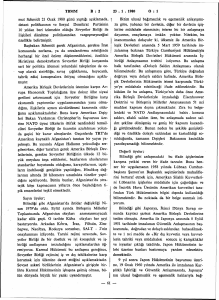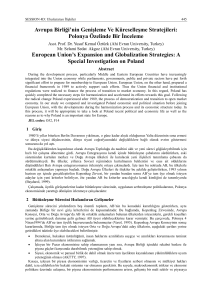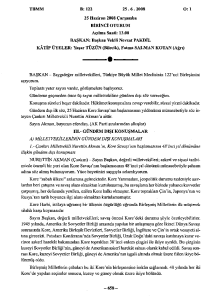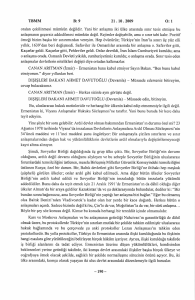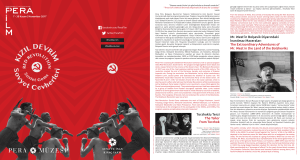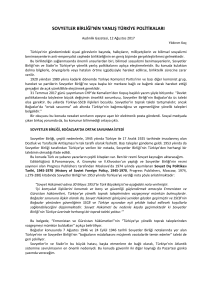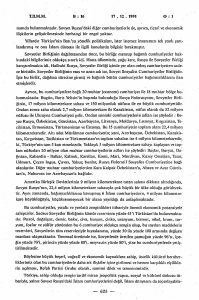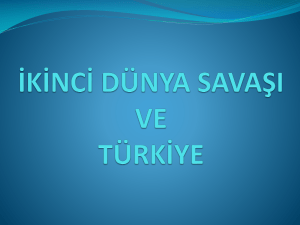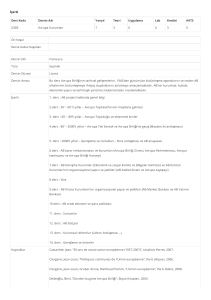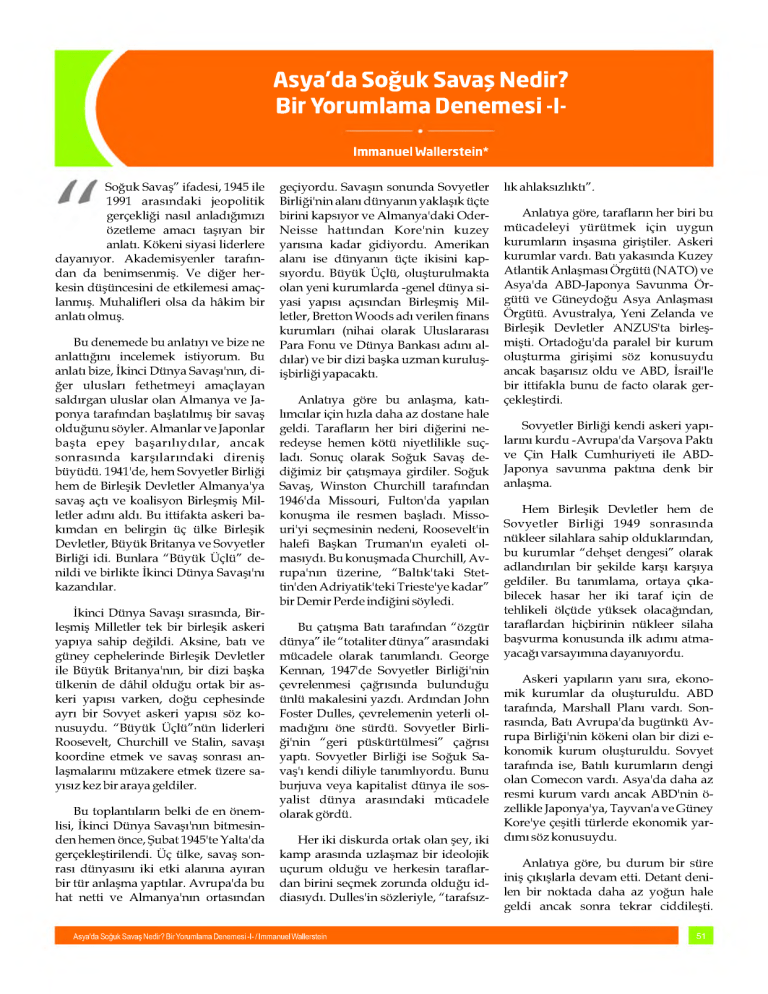
Asya'da Soğuk Savaş Nedir?
Bir Yorumlama Denemesi -IImmanuel Wallerstein*
Soğuk Savaş" ifadesi, 1945 ile
1991 arasındaki jeopolitik
gerçekliği nasıl anladığımızı
özetleme amacı taşıyan bir
anlatı. Kökeni siyasi liderlere
dayanıyor. Akademisyenler tarafın­
dan da benimsenmiş. Ve diğer her­
kesin düşüncesini de etkilemesi amaç­
lanmış. Muhalifleri olsa da hâkim bir
anlatı olmuş.
Bu denemede bu anlatıyı ve bize ne
anlattığını incelemek istiyorum. Bu
anlatı bize, İkinci Dünya Savaşı'nın, di­
ğer ulusları fethetmeyi amaçlayan
saldırgan uluslar olan Almanya ve Ja­
ponya tarafından başlatılmış bir savaş
olduğunu söyler. Almanlar ve Japonlar
başta epey başarılıydılar, ancak
sonrasında karşılarındaki direniş
büyüdü. 1941'de, hem Sovyetler Birliği
hem de Birleşik Devletler Almanya'ya
savaş açtı ve koalisyon Birleşmiş Mil­
letler adını aldı. Bu ittifakta askeri ba­
kımdan en belirgin üç ülke Birleşik
Devletler, Büyük Britanya ve Sovyetler
Birliği idi. Bunlara "Büyük Üçlü" de­
nildi ve birlikte İkinci Dünya Savaşı'nı
kazandılar.
İkinci Dünya Savaşı sırasında, Bir­
leşmiş Milletler tek bir birleşik askeri
yapıya sahip değildi. Aksine, batı ve
güney cephelerinde Birleşik Devletler
ile Büyük Britanya'nın, bir dizi başka
ülkenin de dâhil olduğu ortak bir as­
keri yapısı varken, doğu cephesinde
ayrı bir Sovyet askeri yapısı söz ko­
nusuydu. "Büyük Üçlü"nün liderleri
Roosevelt, Churchill ve Stalin, savaşı
koordine etmek ve savaş sonrası an­
laşmalarını müzakere etmek üzere sa­
yısız kez bir araya geldiler.
Bu toplantıların belki de en önem­
lisi, İkinci Dünya Savaşı'nın bitmesin­
den hemen önce, Şubat 1945'te Yalta'da
gerçekleştirilendi. Üç ülke, savaş son­
rası dünyasını iki etki alanına ayıran
bir tür anlaşma yaptılar. Avrupa'da bu
hat netti ve Almanya'nın ortasından
geçiyordu. Savaşın sonunda Sovyetler
Birliği'nin alanı dünyanın yaklaşık üçte
birini kapsıyor ve Almanya'daki OderNeisse hattından Kore'nin kuzey
yarısına kadar gidiyordu. Amerikan
alanı ise dünyanın üçte ikisini kap­
sıyordu. Büyük Üçlü, oluşturulmakta
olan yeni kurumlarda -genel dünya si­
yasi yapısı açısından Birleşmiş Mil­
letler, Bretton Woods adı verilen finans
kurumları (nihai olarak Uluslararası
Para Fonu ve Dünya Bankası adını al­
dılar) ve bir dizi başka uzman kuruluşişbirliği yapacaktı.
Anlatıya göre bu anlaşma, katı­
lımcılar için hızla daha az dostane hale
geldi. Tarafların her biri diğerini ne­
redeyse hemen kötü niyetlilikle suç­
ladı. Sonuç olarak Soğuk Savaş de­
diğimiz bir çatışmaya girdiler. Soğuk
Savaş, Winston Churchill tarafından
1946'da Missouri, Fulton'da yapılan
konuşma ile resmen başladı. Missouri'yi seçmesinin nedeni, Roosevelt'in
halefi Başkan Truman'ın eyaleti ol­
masıydı. Bu konuşmada Churchill, Av­
rupa'nın üzerine, "Baltık'taki Stettin'den Adriyatik'teki Trieste'ye kadar"
bir Demir Perde indiğini söyledi.
Bu çatışma Batı tarafından "özgür
dünya" ile "totaliter dünya" arasındaki
mücadele olarak tanımlandı. George
Kennan, 1947'de Sovyetler Birliği'nin
çevrelenmesi çağrısında bulunduğu
ünlü makalesini yazdı. Ardından John
Foster Dulles, çevrelemenin yeterli ol­
madığını öne sürdü. Sovyetler Birliği'nin "geri püskürtülmesi" çağrısı
yaptı. Sovyetler Birliği ise Soğuk Savaş'ı kendi diliyle tanımlıyordu. Bunu
burjuva veya kapitalist dünya ile sos­
yalist dünya arasındaki mücadele
olarak gördü.
Her iki diskurda ortak olan şey, iki
kamp arasında uzlaşmaz bir ideolojik
uçurum olduğu ve herkesin taraflar­
dan birini seçmek zorunda olduğu id­
diasıydı. Dulles'in sözleriyle, "tarafsız­
Asya'da S oğukSavaş N edir?BirYorum lam a Denem esi-I-/Im m anuelW allerstein
lık ahlaksızlıktı".
Anlatıya göre, tarafların her biri bu
mücadeleyi yürütmek için uygun
kurumların inşasına giriştiler. Askeri
kurumlar vardı. Batı yakasında Kuzey
Atlantik Anlaşması Örgütü (NATO) ve
Asya'da ABD-Japonya Savunma Ör­
gütü ve Güneydoğu Asya Anlaşması
Örgütü. Avustralya, Yeni Zelanda ve
Birleşik Devletler ANZUS'ta birleş­
mişti. Ortadoğu'da paralel bir kurum
oluşturma girişimi söz konusuydu
ancak başarısız oldu ve ABD, İsrail'le
bir ittifakla bunu de facto olarak ger­
çekleştirdi.
Sovyetler Birliği kendi askeri yapı­
larını kurdu -Avrupa'da Varşova Paktı
ve Çin Halk Cumhuriyeti ile ABDJaponya savunma paktına denk bir
anlaşma.
Hem Birleşik Devletler hem de
Sovyetler Birliği 1949 sonrasında
nükleer silahlara sahip olduklarından,
bu kurumlar "dehşet dengesi" olarak
adlandırılan bir şekilde karşı karşıya
geldiler. Bu tanımlama, ortaya çıka­
bilecek hasar her iki taraf için de
tehlikeli ölçüde yüksek olacağından,
taraflardan hiçbirinin nükleer silaha
başvurma konusunda ilk adımı atma­
yacağı varsayımına dayanıyordu.
Askeri yapıların yanı sıra, ekono­
mik kurumlar da oluşturuldu. ABD
tarafında, Marshall Planı vardı. Son­
rasında, Batı Avrupa'da bugünkü Av­
rupa Birliği'nin kökeni olan bir dizi e­
konomik kurum oluşturuldu. Sovyet
tarafında ise, Batılı kurumların dengi
olan Comecon vardı. Asya'da daha az
resmi kurum vardı ancak ABD'nin ö­
zellikle Japonya'ya, Tayvan'a ve Güney
Kore'ye çeşitli türlerde ekonomik yar­
dımı söz konusuydu.
Anlatıya göre, bu durum bir süre
iniş çıkışlarla devam etti. Detant deni­
len bir noktada daha az yoğun hale
geldi ancak sonra tekrar ciddileşti.
51
1980'lerde, Reagan ABD başkanı oldu
ve Sovyetler Birliği'ne "şeytan impara­
torluğu" adını taktı. 1985'te Sovyetler
Birliği'nin liderliğine Mihail Gorbachev geldi. Perestroyka ve glasnost ile
Sovyet yapılarını reforme etmeyi
denedi.
Tüm bunların bir sonucu, 1989'da
doğu ve orta Avrupa'daki eski Sovyet
uydularında bir dizi kansız devrim
oldu ve nihayet 1991'de Sovyetler Bir­
liği yıkıldı. Böylelikle, anlatıya göre,
1991'de ABD'nin Soğuk Savaş'ı ka­
zandığını söylüyoruz. Bu, iki kutuplu
dünyanın sonuydu; tek kutuplu bir
dünyaya girmiştik. ABD, Madeleine
Allbright'ın deyişiyle, artık "vazge­
çilmez devlet" haline gelmişti. Hatta
bazıları bunun "tarihin sonu" olduğu­
nu söyleyebildi. Ancak bu bakış açısı
çok uzun süreli olmadı çünkü gerçeği
yansıtmıyordu.
Bu anlatıda altta yatan bir varsayım
söz konusuydu: Bu yıllarda, ya ABD ya
da Sovyetler Birliği'nin inisiyatifi
dışında önemli hiçbir şey yaşanma­
mıştı. Bu nedenle, herhangi bir yerde
ne yaşandığını açıklamak isteyen biri
ABD ve/veya Sovyetler Birliği'nin ne
yaptığına ve neden yaptığına bakma­
lıydı. Bu bilindiğinde, X veya Y ya da
Z'ninneden yaşandığı açıklanabilirdi.
Bu anlatı benim bakış açıma göre
büyük ölçüde bir fantezi. Soğuk Savaş
anlatısı kadar yaygın olmasa da alter­
natif veya karşıt bir anlatı da var. Ba­
ğımsızlık sonrasında Hindistan kendi­
sini Soğuk Savaş'ta tarafsız ilan ettiğin­
de ve Birleşmiş Milletler'de bu konumu
yansıtacak şekilde oy kullanmaya baş­
ladığında, politikası bu alternatif anla­
tıya dayanıyordu. Bu diğer anlatı, So­
ğuk Savaş anlatısının, yalnızca iki taraf
olduğuna ve her ülkenin bu taraflar­
dan birinde yer aldığına dair temel ö­
nermesini reddediyordu.
Bu alternatif anlatının destekçileri,
çeşitli kurumsal yapılar inşa etmeye
başladılar. 1995'te, Bandung Konfe­
ransı Asya ve Afrika'nın bağımsız dev­
letlerini bir araya getirdi. Beş Güney
Asya ülkesi tarafından toplanmıştı Hindistan, Pakistan, Sri Lanka, Burma
ve Endonezya. Çin Halk Cumhuriyeti'nin de davetli olduğu ve o toplantıya
geldiği ve burada çok önemli bir rol
52
oynadığı biliniyor. Sovyetler Birliği'nin, bunların da Asya'nın bağımsız
devletleri olduğunu söyleyerek, konfe­
ransın düzenleyicilerinden Orta As­
ya'daki Sovyet Cumhuriyetleri'ni de
davet etmelerini resmen istediği ise
daha az bilinen bir gerçek. Ancak bu
talep düzenleyicilerce reddedildi.
Bundan kısa bir süre sonra Yugo­
slavya, Mısır ve Hindistan başbakan­
ları bir araya geldiler ve bir "bağlantı­
sız" ülkeler toplantısı düzenlemeye ka­
rar verdiler. Bundan böyle çeşitli başka
kurumlar da ortaya çıkacaktı -asıl ola­
rak Küba tarafından toplanan ve Ü­
çüncü Dünya ülkeleri denilen ülkeler­
den sayısız hükümet dışı yapıdan olu­
şan üç-kıtasal (Asya, Afrika ve Latin A­
merika) bir yapı.
Tüm bu yapılar, dünyanın iki ku­
tuplu yapısının geçerliliğini reddetme
üzerine kuruluydu. 1968'de, bir dünya
devrimi olarak düşündüğüm bir şey
gerçekleşti. Neredeyse her yerde ya­
şanması itibariyle bir dünya devrimiydi. Ben kendim Columbia Üniversitesi'ndeydim ve orada tanıklık ettim.
Pan-Avrupa dünyasında ve dünyanın
sosyalist blok olarak adlandırılan pek
çok kesiminde ve Üçüncü Dünya'da
gerçekleşti. 1968 yılı, bir sembol olarak
işe yarıyor ancak olaylar aslında daha
uzun bir zaman periyodunda, 1966 ila
1970 arasında gerçekleşti. Çin'deki
Kültür Devrimi'ni 1968'deki dünya
devriminin bir parçası olarak değerlen­
diriyorum.
Bu noktada Çinliler üçüncü bir jeo­
politik anlatı ortaya attılar. Dünyanın
ve diğer herkesin iki süper güç tara­
fından bölündüğünü öne sürdüler. Bu,
ABD bloğu ile Sovyet bloğu veya Gü­
ney ile Kuzey arasında olmaktan çok,
dünyanın ABD ve Sovyetler Birliği bir
tarafta, kalan herkes ise diğer tarafta o­
lacak şekilde bölünmesiydi. Rothwell
ve Johansson'un bu incelemede kendi
bölümlerinde gösterdikleri üzere, bu
anlatı Latin Amerika ve İsveç gibi şaşır­
tıcı yerlerde kök salıyordu. Bir süre bu
üçüncü anlatı, özellikle de 1968'deki
dünya devriminin parçası olan çeşitli
hareketlere katılanlar arasında geniş
kabul gördü. Ancak terminolojinin
dünyanın farklı kısımlarında biraz
farklılaştığını belirtmek gerekir. Bu ü­
çüncü anlatıyı kabul edenlerin temel
fikri, ABD'nin egemen bir emperyalist
güç olduğu -tam da Vietnam savaşı dö­
nemiydi- ve Sovyetler Birliği'nin ise, e­
gemen bir emperyalist güç olarak ABD
ile gizli bir anlaşma içinde olduğuydu.
Bu üçüncü anlatı -iki süper güç ve
geri kalan herkes arasında bir ayrım1970'leri çıkaramadı. Ancak ikinci
anlatı, Kuzey Güney ayrımı, taraftar
toplamaya devam etti. Bunun, 1945 ile
1991 arasında ne yaşandığını anlamak
için hâkim Soğuk Savaş anlatısından
daha iyi bir entelektüel çerçeve sağla­
dığına inanıyorum. Gerçeklik, hemen
her şeyin Sovyet veya Amerikan istek­
lerinin sonucu olarak gerçekleştiği,
Birleşik Devletler ile Sovyetler Birliği'nin her yerde ve her şeyin birincil ak­
törü olduğu anlayışının oldukça öte­
sinde, neredeyse tam tersiydi.
Sovyetler Birliği ve ABD Yalta'da
bir status quo anlaşması yaptı. Ancak
statükoyu dünya çapında uygularken
sürekli sorunlarla karşılaştılar. Olan
şey, statükoya karşı isyan eden pek çok
ülkenin ve hareketin ABD veya Sovyetler Birliği'ni yaptıkları şeyde kendi­
lerini desteklemeye zorlamak için So­
ğuk Savaş dilini kullanmasıydı.
Soğuk Savaş, her bakımdan 1991'de
sona erdi. Ancak her yerde aynı şekilde
sona ermedi. Avrupa'da, tüm komü­
nist devletler yıkıldı. Ancak, ikisinde
ekonomi politikalarında radikal de­
ğişimler olsa da, Asya'daki üç ana ko­
münist devlette -Çin Halk Cumhu­
riyeti, Kore Demokratik Halk Cumhu­
riyeti ve Vietnam- komünist partiler
iktidarda kaldılar. (Küba'da da, Küba
Komünist Partisi iktidarda.) Avrupa
devletleri ile aradaki bu farkın sebebi
ne?
Avrupa ile Asya arasında ikinci bir
fark daha var. Avrupa'da sona eren sa­
vaş "soğuk"tu ancak Asya'daki son
derece "sıcak"tı. Neden? Bunun tesadüfî olduğunu düşünmüyorum. Hep­
sinden önce, "soğuk" savaş derken
kastettiğimiz şey, ne ABD ne de Sovyetler Birliği'nin bir diğerine karşı mü­
cadelede ordusunu kullanmasıydı. Bu
elbette ki doğru. ABD ile Sovyetler Bir­
liği arasında gerçekten karşılıklı ateş
edildiği bir anı düşünmek çok zor.
Yalta anlaşması ateş edilmeyeceği, ta­
raflardan hiçbirinin 1945'te oluşturulan
A sya'daS oğukS avaşN edir?B irYorum lam aD enem esi-I-/Im m anuelW allerstein
cepheleri değiştirmeye girişmeyeceği
üzerine bir anlaşma ise, o zaman bu an­
lamda Yalta anlaşması son derece ba­
şarılıydı. Öncelikli amacına ulaştı. An­
cak esasen Avrupa'da ulaştı.
Tarihi gözden geçireyim. Avru­
pa'da elbette ki tekrarlanan siyasi "k­
rizler" söz konusuydu. Bunların ilki,
Berlin şehrinin Doğu Almanya'nın Rus
bölgesi tarafından çevrili olması gibi,
Almanya'nın karmaşık sınırlarından
kaynaklanan Berlin kriziydi. Batılı
güçler, Sovyet bölgesini karadan geçe­
rek Batı Berlin'deki işgal bölgelerine
mühimmat yolladılar. 1948'de, Sovyetler Birliği kara güzergâhını kapattı ki
bunun anlamı Berlin'in batı (ABD, In­
giliz ve Fransız) kesiminin bloke e­
dilmesiydi. ABD Berlin bölgelerindeki
halkı uçakla veya diğer şekillerde bes­
lemeye karar verdi. Sovyetlerin Doğu
Almanya'yı izinsiz geçerken bu uçak­
ları pekâlâ vurabilecek olmasına rağ­
men vurmamasının sebebi, Yalta'nın
anahtar kuralıydı: ateş edilmeyecekti.
Sonunda, Sovyetler Birliği kara am­
bargosunu kaldırdı ve dünya tekrar
önceki statükoya döndü.
Doğu Avrupa'daki ilk ayaklanma
1953'te, Berlin'in Sovyet kesiminde ger­
çekleşti. Bu komünizme karşı bir halk
isyanıydı. Batı, ayaklanmacıları des­
tekledi mi? Hiç ses etmediler, tek söz
bile söylemediler. 1956'da Polonya ve
Macaristan'da çok daha ciddi ayaklan­
malar yaşandı. Bunlar Ruslar tarafın­
dan gaddarca bastırıldı. Batı bu konu­
da bir şey yaptı mı? Amerika'nın Sesi'nde Macaristan'da neler olduğuna
dair yayınlar yapıldı ve haberler veril­
di. Ancak asker gönderildi mi? Hayır.
1968'de Polonya ve Çekoslovakya'da
bir dizi ayaklanma daha yaşandı. Sovyetler Birliği yine ayaklanmayı bas­
tırmak için Çekoslovakya'ya asker
gönderdi. ABD bu konuda bir şey yaptı
mı? Kesinlikle hayır. 1980, Polonya'da
Dayanışma Hareketi'ni gördü. Bu ha­
reket bir yıl boyunca gelişti ve güç ka­
zandı. Bir noktada Sovyetler Birliği
yine asker göndermekle tehdit etti. An­
cak Polonya Komünist Partisi Başkanı
General Jaruzelski, Sovyetlere asker
göndermelerine gerek olmadığını söy­
ledi, çünkü bununla içerde baş ede­
cekti. Yaptı da. ABD bir şey yaptı mı?
Kesinlikle hiçbir şey yapmadı.
Soğuk Savaş Avrupa'da soğuktu
çünkü ABD ve Sovyetler Birliği bunun
soğuk bir savaş olması, taraflardan
hiçbirinin sınırları değiştirmek için bir
şey yapmayacağı konusunda anlaş­
mıştı. Sınırları değiştirmek için yapılan
tek girişim, 1946'da Yunan Komünist
Partisi Yunan İç Savaşı'nı yürütürken
yaşandı. Yunan komünistler bir nok­
tada kazanıyorlardı ve iktidara da
gelebilirlerdi. Gelemediler çünkü Sovyetler Birliği Yalta'da yapılan anlaş­
maya göre onları desteklemeyi red­
detti. Sovyetler Birliği mühimmat des­
teğini kesti ve Yunan iç savaşı 1949'da
sona erdi.
Avrupa'da yaşanan buydu. Yalta
öncelikle Avrupa üzerine yapılmış bir
anlaşmaydı. Yalta imzalandığında,
Asya'ya dair bir anlaşma olduğu belir­
gin değildi. İlk sorun Çin'di. İkinci
Dünya Savaşı sona erdiğinde, Çin Ko­
münist Partisi ile Kuomintang ara­
sındaki iç savaş devam etti. Japon­
ya'yla olan savaş sırasında kısmen as­
kıya alınmıştı ancak Japonya'nın yenil­
gisi sonrasında tekrar başladı. Çin Ko­
münist Partisi 1945'de gayet iyi gidi­
yordu ve aynen devam edeceklerini
düşünüyor görünüyorlardı. Ancak Stalin, Mao Zedung'a ÇKP'nin Şangay'a
yürümemesi üzerine güçlü tavsiye­
lerde bulundu. Bunun yerine, ÇKP'nin
Kuomintang ile iktidar paylaşımına
dayanan bir tür anlaşma yapmasını ö­
nerdi.
Bu, Stalin'in Yalta'nın bir versiyo­
nunu Çin'e empoze etme girişimiydi.
Mao Zedung onu görmezden gelmeye
karar verdi. Çin'deki sıcak savaş
devam etti çünkü Çinliler Sovyetler
Birliği'nin isteklerine itibar etmemeye
karar verdiler. Kuomintang anakara­
dan püskürtüldü. Çin'in parçası olan
bir adanın Tayvan olarak anılması bir
coğrafi kazadır. Çin ordusu 1949'da
Tayvan'ı işgal edecek güçte değildi.
Tayvan anakaranın parçası olsaydı,
bugün şüphesiz ki tıpkı Çin'in geri ka­
lanı gibi ÇHC'nin parçası olacaktı.
Ancak o zaman, ABD öne çıktı ve Tay­
van Boğazı'nın yeni sınır hattı oldu­
ğunu iddia etti. Durumu dondurmaya
çalışarak, yeni sınırı hiçbir tarafın geçe­
meyeceğinde ısrar ettiler. Ancak,
1949'da Çin Halk Cumhuriyeti'nin ku­
rulması ile noktalanan sıcak savaşa yol
açan şey, ne ABD'nin ne de Sovyetler
Asya'da S oğukSavaş N edir?BirYorum lam a Denem esi-I-/Im m anuelW allerstein
Birliği'nin inisiyatifiydi. İnisiyatif
ÇKP'nin elindeydi.
Sonraki sıcak savaş Kore'ydi. 1950'de ne olduğuna ve bunu kimin başlat­
tığına dair akademisyenler arasında
epeyce tartışma var. İhtimal verme­
diğim bir olasılık, Stalin'in Kremlin'de
telefonu eline alıp Kim İl Sung'a Güney
Kore'yi işgal etmesini söylediğidir. İlk
adımı kimin attığına dair tartışmalar
olsa da, askeri olarak neler olduğu
konusunda kafamız net. Kuzey Kore
Güney'e asker yolladı ki bunlar başarılı
da oldular. Ardından General Mac Arthur durumu tersine çevirebildi, Kuzey
Korelileri geriletti ve kuzeye ilerledi.
Bir noktada, Yalu Nehri'ne ve ötesine
dek yürümeye hazırmış gibi göründü.
Mac Arthur bunu yapmadan önce, Çin
hükümeti asker yolladı ve geri püs­
kürttü. Bu noktada Mac Arthur nük­
leer silah kullanmak istedi. Ne oldu?
Birleşik Devletler Başkanı onu görev­
den aldı. Mac Arthur Birleşik Devlet­
lerde çok popüler bir adamdı, bu yüz­
den bunu yapmak siyaseten zor bir ka­
rardı. Ancak bu, Yalta'da yapılan anlaş­
manın bir parçasıydı -ABD bunun için
Sovyetler Birliği ile savaşa girme ris­
kini almadı. Peki, Kore savaşı nerede
sona erdi? Tam olarak başladığı yerde.
Sınır çizgisi savaştan önce neresi ise
tam olarak orası kaldı.
Asya'daki sonraki dikkate değer
gelişme Vietnam'dı. Japonya İkinci
Dünya Savaşı sırasında Vietnam'ı işgal
etmişti. Ho Şi Min ve Viet Min Ja­
ponya'ya karşı önemli bir siyasi gerilla
hareketi yürüttüler. Savaşın sonunda,
maksimum tam bağımsızlıkla mini­
mum otonomi arayışı ile halen yasal
olarak kolonyal güç olan Fransa'yla
masaya oturmak istediler. Fransızlar,
kolonyal egemenliği yeniden elde et­
mek niyetiyle, bunu reddetti. Böyle­
likle Fransızlar ile Viet Min arasında
savaş patlak verdi. Fransızlar savaşta
başarılı olamadılar ve Dien Bien
Phu'da kesin bir mağlubiyete uğra­
dılar.
Ardından Cenevre'de durumu ya­
tıştırmak için çok devletli bir toplantı
yapıldı. Birleşik Devletler Cenevre'ye
gitme konusunda çok isteksizdi. O za­
man Pierre Mendes France liderli­
ğindeki Fransız hükümeti, Fransız
askerlerini geri çekmek istedi. Böy­
53
lelikle Cenevre konferansı, Vietnam'ı
kuzey ve güney olarak ikiye böldü ve
yeni bir sınır yarattı. Birleşik Devletler
anlaşmayı imzalamayı reddetti.
Düzenlemenin bir bölümü, Viet­
nam çapında serbest seçimlerin yapıl­
masıydı ve ABD Güney Vietnam hü­
kümetinin destekçilerinin seçimi
kaybedeceklerinden korktu. Savaş
tekrar başladı ve Viet Min'le savaşan
Fransızların yerini ABD askerleri aldı.
Sovyetler Birliği asker yolladı mı? Ha­
yır. Mühimmat desteği ile askeri
yardımda bulundu mu? Evet, çünkü
Vietnamlılar Soğuk Savaş retoriğini
Sovyetler Birliği'ni buna zorlayacak
şekilde kullandılar. Ancak Sovyet
yardımları çok sınırlıydı.
ABD savaşta kesin bir yenilgiye
uğradı. Bu çok önemli bir gelişmeydi.
Devasa jeopolitik etkilere yol açtı. Bi­
rincisi, Birleşik Devletlere son derece
pahalıya mal oldu. Ki sonuç olarak pa­
ra sistemini değiştirmek zorunda kaldı.
Siyasi olarak da son derece pahalıya
patladı. İç politikada, ABD halkının
büyük bir kesimi ABD politikalarına
isyan etti. Güncel mağlubiyet ile
A B D' d e k i y a yg ı n m u h a l e f e t i n
birleşmesi, Vietnam sendromu dedi­
ğimiz sonuca yol açtı ve Güney Küre'deki savaşlara katılma konusunda
Birleşik Devletlerde yaygın bir halk
isteksizliği yarattı. ABD içindeki bu
politik sorunla baş etmek için, hükü­
met zorunlu askerliği kaldırdı ancak
bu elbette ki gelecekteki askeri ola­
sılıkları engelliyordu.
Vietnam Savaşı'nda Sovyetler Bir­
liği esas oyunculardan biri miydi? Hiç
de değil. Birleşik Devletler öyle miydi?
Sadece ikincil olarak. Bunların her­
hangi biri Sovyetler Birliği ile ABD
arasında bir nükleer savaş riski yara­
tacak şekilde davrandı mı? Hayır.
Sonrasında ise 1980'lerde Sovyetlerin Afganistan'ı işgali vardı ki bu bir
miktar Yalta'nın ihlali gibi görünü­
yordu. Ancak asla yalnızca dolaylı o­
larak müdahil olan Birleşik Devletler
ile askeri bir cepheleşme şeklini al­
madı. Her durumda Sovyet işgali
Sovyetler Birliği için, ABD'nin Viet­
nam'daki yenilgisine benzeyen tam bir
felaket oldu ve en sonunda Sovyetler
geri çekildi.
54
Küba vakası da bir benzeridir. Fidel
Castro, Batista rejimini destekleyen
Küba Komünist Partisi ile siyasi olarak
tam bir uzlaşmazlık içinde olan bir
gerilla hareketinin lideri olarak ikti­
dara geldi. Castro, rejimini devirmek
isteyen ABD hükümeti ile çok büyük
zorluklar yaşadı. Bu nedenle Castro
yaşamı boyunca bir komünist oldu­
ğunu açıkladı. Bu, öğrenci-Marksist
anlamında, belki de doğruydu ancak
partinin bir üyesi değildi. Daha sonra
Küba Komünist Partisi'ni Fidelciler ele
geçirdi ve bu Sovyetler Birliği'ni, Soğuk
Savaş mantığıyla, Küba rejimini bir
ABD işgaline karşı savunmaya zorladı.
Küba Füze Krizi ortaya çıktığında,
ABD Küba'ya asker göndermedi, ABD
ve Sovyetler Birliği de facto bir a­
teşkeste anlaştılar ve askeri çatışmayı
engellediler.
Böylelikle, Çinliler, Vietnamlılar ve
Kübalıların tümü, statüko da arzu et­
tikleri değişimleri elde etmek için
Sovyetler Birliği'ni kullanmış oldu.
Ancak bu durum karşılıklı değildi.
Çinlileri, Vietnamlıları veya Kübalıları
kullanan Sovyetler Birliği değildi.
Hatta Sovyetler Birliği isteksiz bir müt­
tefikti.
Şimdi de 1989-1991 Avrupa'sında
yaşananlara bir bakalım. Soğuk Savaş
anlatısına göre, dünya iki kutuplu bir
durumdan Birleşik Devletlerin ilk kez
sorgulanmayan bir süper güç haline
geldiği tek kutupluya geçmişti. Karşı
anlatıya göre ise, olanlar epey bir fark­
lıydı.
Sovyetler Birliği'nin yıkılması,
ABD'nin bakış açısına göre, kesin bir
jeopolitik yıkımdı, çünkü iki şeyi devre
dışı bıraktı. ABD'nin müttefiklerine ve
komünist olmayan dünyanın geri
kalanına, Sovyetler Birliği denilen bir
düşmana karşı cephe oluşturmak a­
macıyla Birleşik Devletlerin siyasi ön­
derliğini izlemeleri gerektiğini dayat­
mak için kullandığı Soğuk Savaş
argümanlarını geçersizleştiriyordu.
İkincisi, bu durum, Sovyetler Birliği'nin az ya da çok kendi tarafında olan­
ları, ABD ile Sovyetler Birliği arasında
askeri bir çatışmaya yol açma olasılığı
olan eylemlere girişmekten alıkoyması
durumunu ortadan kaldırdı.
da Sovyetler Birliği çöktüğü için işgal
etmeye kalkışabildiğini öne sürüyo­
rum. Bunu beş yıl önce yapmaya asla
cesaret edemezdi. Çünkü Sovyetler
Birliği bunun Birleşik Devletler ile Sovyetler Birliği arasında bir nükleer sa­
vaşa yol açacağını söyler ve izin ver­
mezdi. Saddam Hüseyin'in ipini salan,
Sovyetlerin yıkılmasıydı.
Soğuk Savaş'a bir anlatı olarak ba­
kıldığında, gerçekliği açıklama konu­
sunda başarısız olduğunu düşünü­
yorum. Bence olan şey daha çok,
Birleşik Devletlerin, dünyada denk bir
askeri yapıya sahip tek ülke olan Sovyetler Birliği ile egemenliği koruma ve
sağlama alma konusunda bir anlaşma
yapma girişimi idi. Anlaşma bir statü­
ko anlaşmasıydı. Ancak taraflardan
hiçbiri uzun vadede bunu geçerli kıl­
mayı başaramadı. Sovyetler Birliği'nin
yavaş yavaş yıkılışı, Sovyetler Birliği
Komünist Partisi'nin 1956'daki kong­
resiyle ve 1960'ta Çin'le yolları ayırma­
sıyla başladı. O noktadan sonra Sovyetler Birliği giderek daha da zayıfladı.
Aynı şey, Batı Avrupa'nın 1970'lerden
itibaren kendisini özgürleştirmeye
başlamasıyla birlikte, ABD için de söz
konusuydu. Batı Avrupalılar artık
uydu muamelesi görmek istemiyor­
lardı ve ABD bir dizi ödün vermeye
zorlandı. Bu süreci Sovyetler Birliği'nin
yıkılması kadar hızlandıran bir şey
yok. Aslında, onu daha da hızlandıran
bir şey daha var ve bu da George W.
Bush'un, devasa bir geri tepmeye yol
açarak ABD'nin baş aşağı düşüşünü
hızlandıran, tek taraflı maço militarizm
ile ABD hegemonyasını yeniden tesis
etme girişimiydi.
Her birinin izlediği politikaların
yanı sıra, Birleşik Devletler ile Sovyetler Birliği'nin Asya'daki ilişkileri de
Avrupa'daki ilişkilerinden son derece
farklıydı. Asya'da bir Soğuk Savaş'tan
bahsetmek pek de faydalı değil.
*wordpress.com/tag/ immanuel-wallerstein/
Saddam Hüseyin'in, Kuveyt'i, tam
Asya'da SoğukSavaş Nedir? BirYorumlama Denemesi -I-/Im m anuelW allerstein
What Cold War In Asia?
An Interpretative Essay -IImmanuel Wallerstein*
he phrase "the Cold War" refers
to a narrative that was intended
to and is supposed to summarize how we are to understand a geopolitical reality over the period of time
running approximately from 1945 to
1991. This narrative is today very widely accepted. It originated with political leaders. It was adopted by scholars. And it was intended to infi
uence the thinking of everyone else. It
has been the dominant narrative, although there have been some dissenters.
T
In this essay I would like to review
this narrative and what it is supposed
to tell us. It tells us that the Second
World War was a war that was started
by Germany and Japan as aggressor
na-tions that sought to conquer other
nations. They did fairly well at fi rst,
but then resistance to them grew stronger. In 1941, both the Soviet Union and
the United States entered the war against Germany, and the coalition took on
the name of the United Nations. The
three countries in this alliance that
were most signifi cant militarily were
the United States, Great Britain and the
Soviet Union. They were called the
"Big Three," and together they won the
SecondWorldWar.
During the Second World War, the
United Nations did not have a single
unified military structure. Rather, there
was on the western and southern fronts
a joint military structure of the United
States and Great Britain, in which a
number of other countries joined, while on the eastern front there was a separate Soviet military structure. In order
to work together, the leaders of the "Big
Three"-Roosevelt, Churchill and Stalin-met several times to coordinate the
conduct of the war and to discuss postwar arrangements.
Perhaps the most famous meeting
was the one that occurred just before
the end of the Second World War, in
February 1945, at Yalta. The three
countries made, in effect, a kind of deal
that involved a division of the postwar
world into two spheres of infi uence. In
Europe, the line of division was specifi
c and was drawn across the middle of
Germany. At the end of the war, the
Soviet Union's sphere covered approximately one-third of the world, running from the Oder-Neisse line in
Germany to the northern half of Korea.
The American sphere covered the other
two-thirds of the world. The Big Three
were supposed to cooperate in the new
institutions that were being established- the United Nations as the overall
world political structure, the so-called
Bretton Woods fi nancial institutions
(which were eventually called the International Monetary Fund and the
World Bank) and a series of other specialized agencies.
According to the narrative, this agreement, in the views of the participants, quickly became less amicable.
Each side accused the other almost
immediately of bad faith. As a result,
there began a confi ict which we call the
Cold War. The Cold War was more or
less offi cially launched in a speech given by Winston Churchill in Fulton,
Missouri in 1946. He chose Missouri
because it was the home state of Roosevelt's successor, President Truman.
In this speech, Churchill said that an
Iron Curtain had descended over Europe, "from Stettin in the Baltic to Trieste in the Adriatic."
This confict was defi ned in the
West as a struggle between the "free
world" and the "totalitarian world."
George Kennan wrote a famous article
in 1947 callingfor the "containment" of
the Soviet Union. John Foster Dulles
subsequently argued that containment
was not enough. He called for the "rollback" of the Soviet Union. The Soviet
Union had its own language to describe the Cold War. It saw it as a struggle
between the bourgeois or capitalist
world and the socialist world.
W hat Cold W ar InAsia?A n Interpretative Essay - I- / Immanuel W allerstein
What was common to both discourses was the argument that there was
an irreconcilable ideological gulf
between the two camps, and that it was
incumbent on everyone to choose sides. In Dulles's language, "neutralism
was immoral." According to the narrative, each side then began to build
appropriate institutions to carry out
this struggle. There were military institutions.
On the Western side there was the
North Atlantic Treaty Organization
(NATO) and in Asia, the US-Japan Defense Organization and the Southeast
Asia Treaty Organization. Australia,
New Zealand and the United States
were joined together in ANZUS. There
was an attempt to establish a parallel
institution in the Middle East, but it
failed and the US made do with a de
facto alliance with Israel.
The Soviet Union established its
own military structures-the Warsaw
pact in Europe and a treaty with the
People's Republic of China (PRC), which was a kind of equivalent of the USJapan defense pact. what cold war in
asia? an interpretative essay 17 Since
the United States and the Soviet Union
after 1949 both had nuclear weapons,
these institutions faced each other in
what was called a "balance of terror."
This phrase refers to the presumption
that neither side would be the fi rst to
launch nuclear weapons, because a response was certain, and the damage to
both sides would be too dangerously
high.
Besides military structures, economic institutions were also established.
On the US side there was the Marshall
Plan. Later, a whole series of economic
institutions was created in Western Europe, which ultimately led to the European Union of today. On the Soviet side
there was the Comecon, which was
supposed to be a kind of counterpart to
the Western institutions. In Asia there
were less formal institutions, but there
55
was a good deal of US economic assistance of various kinds to Japan, Taiwan
and South Korea in particular.
According to the narrative, this situation continued for some time with ups
and downs. At some point in time it became less intense, during a period that
was called detente, but then tension became more serious again. In the 1980s,
Reagan became the President of the US,
calling the Soviet Union an "evil empire." In 1985, Mikhail Gorbachev be­
came the leader of the Soviet Union. He
tried to reform the Soviet structure
with perestroika and glasnost.
One outcome of all of this was a series of largely bloodless revolts in 1989
in the erstwhile Soviet satellites in eastcentral Europe, and finally in 1991 came the collapse of the Soviet Union. So,
in this narrative, we say that in 1991 the
US won the Cold War. It was the end of
a bipolar situation; we had entered into
a unipolar world. The US had now become the "indispensable nation," in the
language of Madeleine Albright. Some
even dared to suggest that this was the
"end of history." But this view didn't
last too long because it didn't conform
to reality.
Throughout this narrative, there is
one underlying assumption: that anything important that happened in all
those years was initiated either by the
US or by the Soviet Union. So if one
wanted to explain what was going on
anywhere at all, one had to look at what
the US and/ or the Soviet Union were
doing and why they were presumed to
be doing it. Once one knew that, one
could explain why X or Y or Z had happened.
This narrative is in my view largely
a fantasy. There exists an alternative or
counter-narrative, though it was never
as widespread as the narrative of the
Cold War. When, after independence,
India proclaimed itself neutral in the
Cold War and began to vote in the United Nations in ways that refi ected this
position, its policy was based on this
alternative narrative. This other narrative denied the basic premise of the
Cold War narrative, namely that there
were only two sides, and that every country was either on one side or the
other.
The proponents of this alternative
narrative began to construct various
56
institutional structures. In 1955, the
Bandung Conference gathered the independent states of Asia and Africa. It
was convened by fi ve South Asian nations-India, Pakistan, Sri Lanka, Burma
and Indonesia. It is well known that the
People's Republic of China was invited
and came to that meeting, and played a
very important role at it. It is less well
remembered that the Soviet Union formally requested of the organizers that
they invite the Central Asian republics
of the Soviet Union on the grounds that
they too were independent states of Asia, but the organizers refused.
Shortly thereafter the prime ministers of Yugoslavia, Egypt and India met
and decided to convene a meeting of
"non-aligned" nations. There came to
be various other institutions as well-a
tricontinental structure (of Asia, Africa
and Latin America), originally convened by Cuba, and several non-governmental structures comprised of so-called Third World countries.
All these structures were based on a
rejection of the validity of a bipolar division of the world. In 1968, there occurred what I think of as a world revolution. It was a world revolution in the
sense that it occurred virtually everywhere. I myself was at Columbia University at that time and witnessed it there. It occurred throughout the panEuropean world, in many parts of the
so-called socialist bloc, and throughout
the Third World. The year 1968 is useful as a symbol but the events actually
occurred over a longer period, roughly
1966-1970.
I consider the Cultural Revolution
in China to be part of this world revolution of 1968. At that time the Chinese
put forward a third geopolitical narrative. They asserted that the world was
divided between the two superpowers
and everybody else. That is, rather than
being divided between the US bloc and
the Soviet bloc, or between the North
and the South, the world was divided
between the US and the Soviet Union
on one side and everybody else on the
other side. As Rothwell and Johansson
show in their chapters of this volume,
this narrative took root in such surprising places as Latin America and Sweden. For a time, this third what cold
war in Asia? an interpretative essay 19
narrative had wide acceptance, especially among those who participated in
the various movements that were part
of the world revolution of 1968. To be
sure, the exact terminology varied a bit
in different parts of the world. The basic idea, however, of those that accepted this third narrative was that the US
was a hegemonic imperialist powerthis was the era of the Vietnam warand that the Soviet Union was collusive
with the US as a hegemonic imperialist
power.
This third narrative-a division between the two superpowers and everyone else-did not survive the 1970s. But
the second narrative, that of a NorthSouth division, continued to gain adherents. I believe that it provides a better
intellectual framework to understand
what went on between 1945 and 1991
than the more dominant narrative of
the Cold War. Far from the United
States and Soviet Union being the primary agents of almost everything, everywhere, such that one could explain
almost anything that went on as result
of Soviet or American wishes, the reality was almost the opposite.
The Soviet Union and the US had
made an arrangement at Yalta which
was a status quo arrangement. But they
ran into constant problems in enforcing
the status quo all over the world. What
happened is that many countries and
movements that rebelled against the
status quo used the language of the
Cold War to force the US or the Soviet
Union to support them in what they
were doing. The so-called Cold War
ended, according to all accounts, in
1991. But it didn't "end" in the same
way everywhere. In Europe, all the socalled communist states collapsed. However, in the three principal communist states in Asia-the People's Republic of China, the Democratic People's
Republic of Korea and Vietnam-the
communist parties remain in power,
even if the economic policies of at least
two of the three have changed radically. (In Cuba as well, the Communist
Party of Cuba remains in power.) Why
this difference with the European states?
There is a second difference between Europe and Asia. The cold war
was "cold" in Europe, but it was quite
"hot" in Asia. Why? I don't think that
was accidental. First of all, what we
mean when we say that it was a "cold"
war is that neither the US nor the Soviet
W h atC oldW arInA sia?A nInterpretativeE ssay-I-/Im m anuelW allerstein
Union used its military in combat against the other at any time. That is of
course true. One would be hardpressed to think of a moment in which
there was actually an exchange of shooting between the US and the Soviet
Union. If the Yalta agreement was an
agreement that there would be no shooting, that neither side would attempt
to change the frontiers 20 immanuel
wallerstein that were established in
1945, then in this sense the Yalta agreement was a great success. It achieved its primary objective. But it archieved it primarily in Europe.
Let me review the history. There
were of course repeated political "crises" in Europe. The fi rst was the
Berlin crisis, which derived from the
complicated boundaries in Germany,
such that the city of Berlin was surrounded by the Russian zone of East
Germany. The Western powers sent
supplies to their occupation zones in
West Berlin by land transport across the Soviet zone. In 1948, the Soviet Union closed the land route, which effectively meant that the western (US,
British and French) sectors of Berlin
were blockaded. The US decided to fi y
in planes to feed and otherwise resupply the people of its Berlin zones. The reason the Soviets did not shoot
down those planes as they traversed
East Germany without authorization,
which of course they could have done,
was because of the key rule of Yalta: that there would be no shooting. Eventually, the Soviet Union lifted the land
blockade, and the world was back to
status quo ante.
The first of the uprisings in Eastern
Europe took place in 1953-in the Soviet
sector of Berlin. This was a popular rebellion against communism. Did the
West come in to support the rebels? They uttered not a word, not a sound. In
1956, there were more serious uprisings in Poland and in Hungary. These
were suppressed brutally by the Russians. Did the West do anything about
it? There were broadcasts on the Voice
of America and reports about what was
going on in Hungary.
But were troops sent in? No. In
1968, there was a further series of uprisings in Poland and Czechoslovakia.
Again the Soviet Union sent in troops
to Czechoslovakia to put down this
uprising. Did the US do anything about
it? Absolutely nothing. 1980 saw the
Solidarity Movement in Poland. This
movement evolved and gained strength for over a year. At one point, the
Soviet Union threatened to send in troops again. But the Polish communist
Prime Minister, General Jaruzelski,
told the Soviets that they did not have
to send in troops, because he would
handle it internally. He did. Did the US
do anything? Absolutely nothing.
The Cold War was cold in Europe
because the US and the Soviet Union
had an agreement that it would be a
cold war, that neither side would do
anything to change boundaries. The
one attempt to change the boundaries
was when the Greek Communist Party
resumed the Greek Civil War in 1946.
The Greek communists were at one
point winning, and might have come to
power. They did not do so because what cold war in asia? an interpretative
essay 21 the Soviet Union, in accord
with the agreement made in Yalta, pulled the plug on them and refused to
support them. The Soviet Union cut off
their supplies and the Greek Civil War
came to an end in 1949.
This is what happened in Europe.
Yalta was an agreement primarily about Europe. It was a little vague at the
time of Yalta what the agreement
implied for Asia. The fi rst problem was
China. When the Second World War
came to an end, the civil war between
the Chinese Communist Party (CCP)
and the Kuomintang (KMT) resumed.
It had been partially suspended during
the war with the Japanese, but after the
defeat of Japan it began again. The
Chinese Communist Party was doing
well in 1945 and seemed to think that
they should continue to do well. But Stalin strongly recommended to Mao
Zedong that the CCP not march on Shanghai. Rather, he suggested that the
CCP make some kind of deal with the
Kuomintang, to split power in some
way.
This was Stalin's attempt to enforce
a version of the Yalta arrangement on
China. Mao Zedong decided to ignore
him. The hot war in China continued
because the Chinese decided not to pay
any attention to the wishes of the Soviet
Union. The Kuomintang was pushed
out of the mainland. It is an accident of
geography that there happens to be an
island that is part of China called
W hat Cold W ar InAsia?A n Interpretative Essay - I- /Im m anuel W allerstein
Taiwan. The Chinese army was not strong enough in 1949 to conquer Taiwan. Had Taiwan been part of the
mainland, today it would undoubtedly
be a part of the PRC just like the rest of
China. But at that time, the US stepped
in and proclaimed the Taiwan Strait the
new boundary line.
They insisted that neither side could cross this new boundary, seeking
thereby to freeze the situation. It was
not, however, the initiative of either the
US or the Soviet Union that had led to
the hot war that culminated in the establishment of the People's Republic of
China in 1949. The CCP had called the
shots.
The next hot war that occurred was
in Korea. There is a lot of debate among
scholars as to what actually happened
in 1950 and who started what. One thing that I don't think happened is that
Stalin got on the telephone in the
Kremlin and told Kim Il Sung to invade
South Korea. While there may be debate about who took the fi rst step, we
are clear about what happened militarily. North Korea sent troops into South Korea, where they did quite well.
Then General MacArthur was able to
turn the tide, push back the North Koreans, and march north. At one point,
he seemed ready to march all the way
to the Yalu River and beyond. Before
MacArthur was able to do this, the Chinese government sent in troops and
pushed back. MacArthur wanted to use nuclear weapons at that point. What
happened? The President of the United
States fi ed him. MacArthur was a very
popular man within the United States,
so this was politically very diffi cult to
do. But it was part of the agreement that had been made at Yalta-the US felt
it couldn't risk going to war with the
Soviet Union over this. So where did
the Korean W ar end? It ended just where it began. The boundary line was kept
exactly where it had been before the
war.
The next development of great
signifi cance in Asia was Vietnam. The
Japanese had occupied Vietnam during the Second World War. Ho Chi
Minh and the Viet Minh had led an important political guerrilla movement against the Japanese. At the end of the
war, they wanted to negotiate with France (still juridically the colonial po-
57
wer), seeking at a minimum autonomy
and at a maximum full independence.
The French, intent on restoring colonial
rule, refused. So war broke out between the French and the Viet Minh.
The French did not do well in that war
and ultimately were defeated at Dien
Bien Phu. A multi-state meeting was
then convened in Geneva to settle the
situation. The United States was very
reluctant to go to Geneva. The French
Government was at that point led by
Pierre Mendes-France and he wanted
to withdraw French troops, so the Geneva conferees partitioned Vietnam into north and south, creating a new line.
The United States refused to sign the
agreement. Part of the arrangement
was that free elections throughout Vi­
etnam would be scheduled, and the US
feared that the supporters of the South
Vietnamese government would lose those elections. The war resumed and
US troops replaced the French in fighting the Viet Minh. Did the Soviet
Union send in troops? No. They did
not. Did they help militarily with supplies? Yes, because the Vietnamese made use of the fact that Cold War rhetoric
required the Soviet Union to do so. But
Soviet aid was very limited.
Ultimately the US lost that war. This was very important. It had an enormous geopolitical impact. First of all, it
was hugely expensive for the United
States, which was forced to change its
monetary system as a result. It was also
extremely expensive politically. Internally, a large segment of the US population rebelled against US policy. The
combination of actual defeat and widespread dissent in the US led to what
we call the Vietnam syndrome-a popu­
lar reluctance in the United States to
engage in wars in the global South. To
deal with this political problem within
the US, the government eliminated the
draft, but this of course put a crimp in
future military possibilities. what cold
war in asia? an interpretative essay 23
In the Vietnam War, was the Soviet Union a prime mover? Not at all. Was the
United States a prime mover? Only secondarily. Did either move in such a
way that there was a risk of nuclear war
between the Soviet Union and the US?
No. There was in the 1980s the Soviet
incursion into Afghanistan, which seemed to violate the spirit of Yalta. But it
58
never involved a direct military confrontation with the United States, which
participated only through proxies. In
any case, the Soviet incursion turned
out to be a disaster for the Soviet Union,
akin to the defeat of the US in Vietnam,
and eventually the Soviets withdrew,
ending up at the frontiers from which
theystarted.
The case of Cuba is similar. Fidel
Castro came to power as the leader of a
guerrilla movement that was in total
political disagreement with the Cuban
Communist Party, which had been
supporting the Batista regime. Castro
nonetheless ran into great diffi culty
with the US government, which sought
to overthrow his regime. So Castro announced that he had been a communist
all his life. This was perhaps true in
some student-Marxist sense, but he
was not a member of the party. The
Fidelistas then took over the Cuban
Communist Party, and this forced the
Soviet Union, in the logic of the Cold
War, to defend the Cuban regime against any US invasion. When the Cuban
Missile Crisis occurred, the US did not
send troops to Cuba. Rather, the US
and the Soviet Union negotiated a de
facto truce, thereby avoiding military
confict.
Thus the Chinese and the Vietnamese and the Cubans all used the Soviet Union to achieve the political changes to the status quo which they desired. It was not the other way round. It
was not the Soviet Union that used the
Chinese, the Vietnamese or the Cubans. Indeed, the Soviet Union was the
reluctant ally. Let us now look at the
events of 1989-1991 in Europe. According to the Cold War narrative, the
world moved from a bipolar situation
to a unipolar one, in which the United
States was for the first time the unquestioned supreme power. According to
the counter-narrative, things look quite
different.
The collapse of the Soviet Union
was, from the US point of view, an
absolute geopolitical catastrophe, because it eliminated two things. It eliminated the Cold War arguments that
the US had used to insist that its immediate allies and the rest of the noncommunist world follow the political
lead of the United States, because they
were arrayed against an enemy called
the Soviet Union. Secondly, it eliminated the role of the Soviet Union in restraining people who were more or less
on its side from engaging in actions
that might possibly lead to military
confrontation between the US and the
Soviet Union. I would argue that Saddam Hussein dared to invade Kuwait
precisely because the Soviet Union was
collapsing. He would never have dared
to do it fi ve years earlier, because the
Soviet Union would have said that this
would cause a nuclear war between the
United States and the Soviet Union,
and the Soviet Union could not permit
that. It was the collapse of the Soviet
Union that lifted the constraints on
Saddam Hussein.
If you look at the Cold War as a narrative, I think it fails as an explanation
of reality. I think what was going on
was rather an attempt by the United
States to maintain and ensure its hegemony by making a deal with the only
other country in the world that had a
comparable military structure, the Soviet Union. The deal was a status quo
deal. But neither side was able to enforce it in the long run. The slow collapse of the Soviet Union began with
the 1956 Congress of the Communist
Party of the Soviet Union, and the split
with China in 1960. From that point on
the Soviet Union grew weaker and weaker. The same thing was happening to
the US, as Western Europe began to liberate itself beginninginthe 1970s. The
Western Europeans no longer wished
to be treated as satellites and the US
was forced to make a series of concessions. Nothing accelerated that process
more than the collapse of the Soviet
Union. Actually, there was one thing
that accelerated it still more, and that
was the attempt by George W. Bush to
restore US hegemony through unilateral macho militarism, which backfi red
enormously and accelerated US decline precipitously. The relations of the
United States and the Soviet Union in
Asia, as well as the policies each pursued, were quite different from their relations and their policies in Europe. It is
probably not very useful speak of the
Cold War in Asia.
*wordpress.com/tag/ immanuel-wallerstein/
W h atC oldW arInA sia?A nInterpretativeE ssay-I-/Im m anuelW allerstein
Was Ist Der Kalte Krieg In Asien?
Ein Versuch, Interpretation -IImmanuel Wallerstein*
er "Kalte Krieg" und der Erklarung ist eine Erzahlung, in
dem man die Zusammenfassung erreicht, was die Realitat der Geopolitik zwischen 1945 und 1991 verstanden worden ist. Die Entstehung ertragt auf die politischen Führer. Wurde
auch durch die Akademiker angenommen.
D
Und soll auch die alle anderen Ideens zu beeintrachtigen. Obwohl sie
Gegner hatten, wurde eine herrschenden Erzahlung herausgekommen.
In diesem Versuch möchte ich untersuchen, was er uns erzahlen will und
was er über diese Erzahlung erklarte.
Diese Erzahlung will uns zeigen, dass
der zweite Weltkrieg mit Deutschland
und Japan gestarte, dass sie die aggresive Nation seien und die andere Nationen Offensive zu erobern gerichten.
Die Deutschen und Japaner waren
als erstes sehr erfolgreich, aber nachdem wuchs die gegenüber Wiederstand. Im Jahre 1941, die Sowjetunion
erklarte den Krieg gegen Deutschland
und den Vereinigten Staaten und die
Koalition nahm den Namen der Vereinten Nationen. Die Vereinigten Staaten, die Grofibritannien und der Sowjetunion waren in dieser Allianz die als
militarisches Bündnis, die bestimmten
Drei-Lander. Man hat diese die drei Grossen benannt und sie hatten alle zusammen den zweiten Weltkrieg gewonnen. Wahrend des Zweiten Weltkriegs hatten die vereinten Nationen
bisher keine einheitlichen militarischen
Struktur.
realisiert. Die drei Nationen hatten eine
Vereinbarung getroffen, dass der
Nachkriegswelt in zwei Einflussbereiche sich getrennt hatten. Dieser Netz
war in Europa sehr deutlich und ging
durch Deutschland entlang. Nachdem
Krieg entdeckten die vereinigten Sowjetionen fast ein drittel von der Welt
und ging von da durch der Oder-Neisse bis zur die halfte im Norden der
Korea entlang. Die amerikanische Seite
entdeckte die zwei Drittel der Welt.
Es gab eine andere gemeinsame militarische Struktur bei den USA und
Grofibritannien im Westen und Süden
Fassaden und auch bei den anderen
Landern, die von einer Reihe eingetraten waren. Im Gegenteil gab es bei
den Ostfassaden eine andere sowjetische militarische Struktur Roosevelt,
Churchill ve Stalin, die drei Grossen
traffen sich mehrmals um den Krieg zu
koordinieren und nach dem Krieg die
Vereinbarungen auszuhandeln.
Die drei Grossen, erneuerten Firmen die vereinigten Staaten als der
generellische Welt politische Struktur,
deren Namen Bretton Woods, die finanzielle Firmen (Schliefilich nahm
den Namen des Internationalen Wahrungsfonds und der Weltbank ) und
jenige sachverstandige Stellen -wollten
zusammen arbeiten.
*wordpress.com/tag/ immanuel-wallerstein/
Die wichtigsten Versammlungen
waren vielleicht vor der zweiten Weltkriegsendung im Februar 1945 in Yalta
W as IstD er Kalte Krieg InAsien? EinVersuch, Interpretation -I-/Im m anuelW allerstein
59


